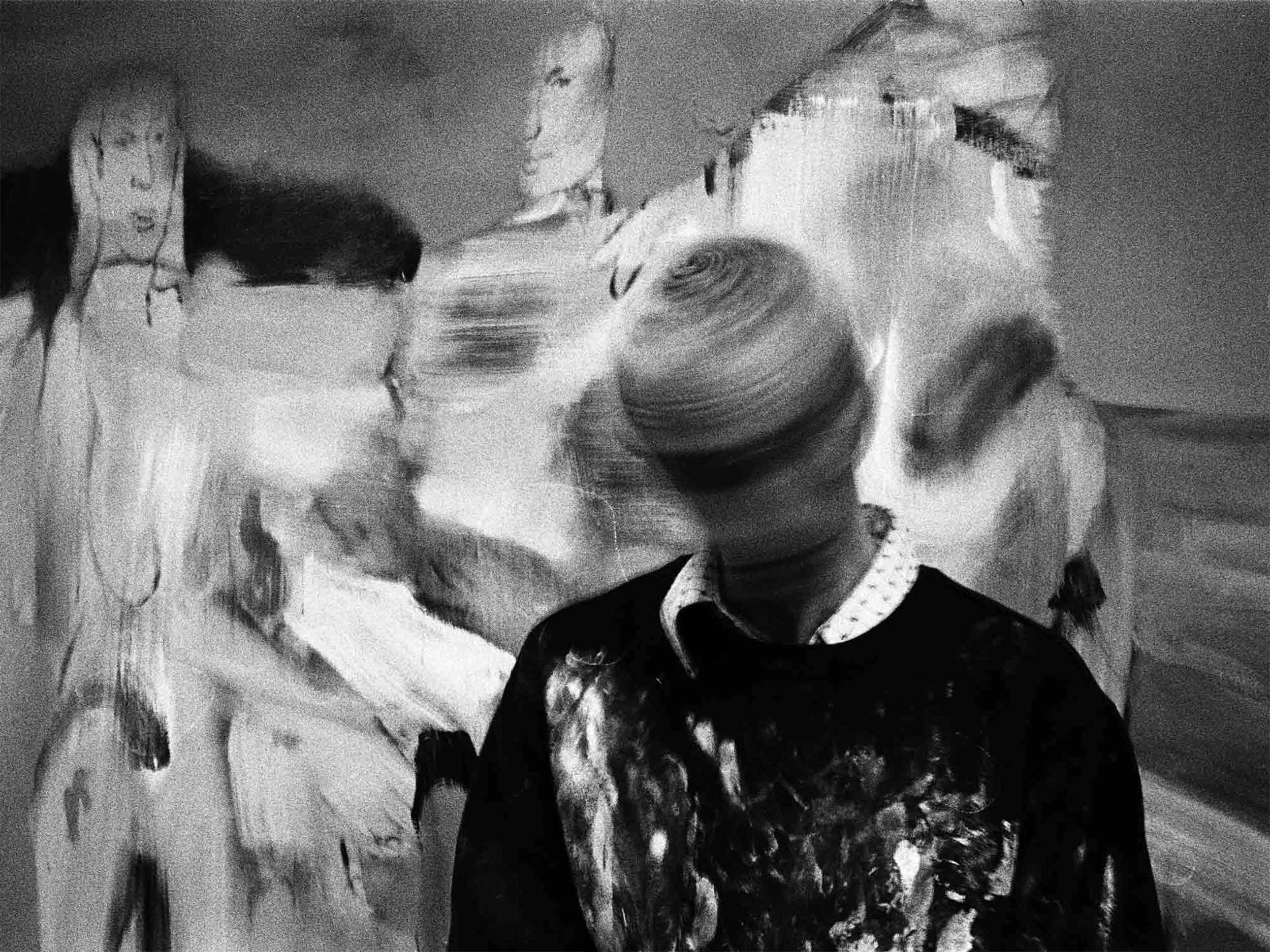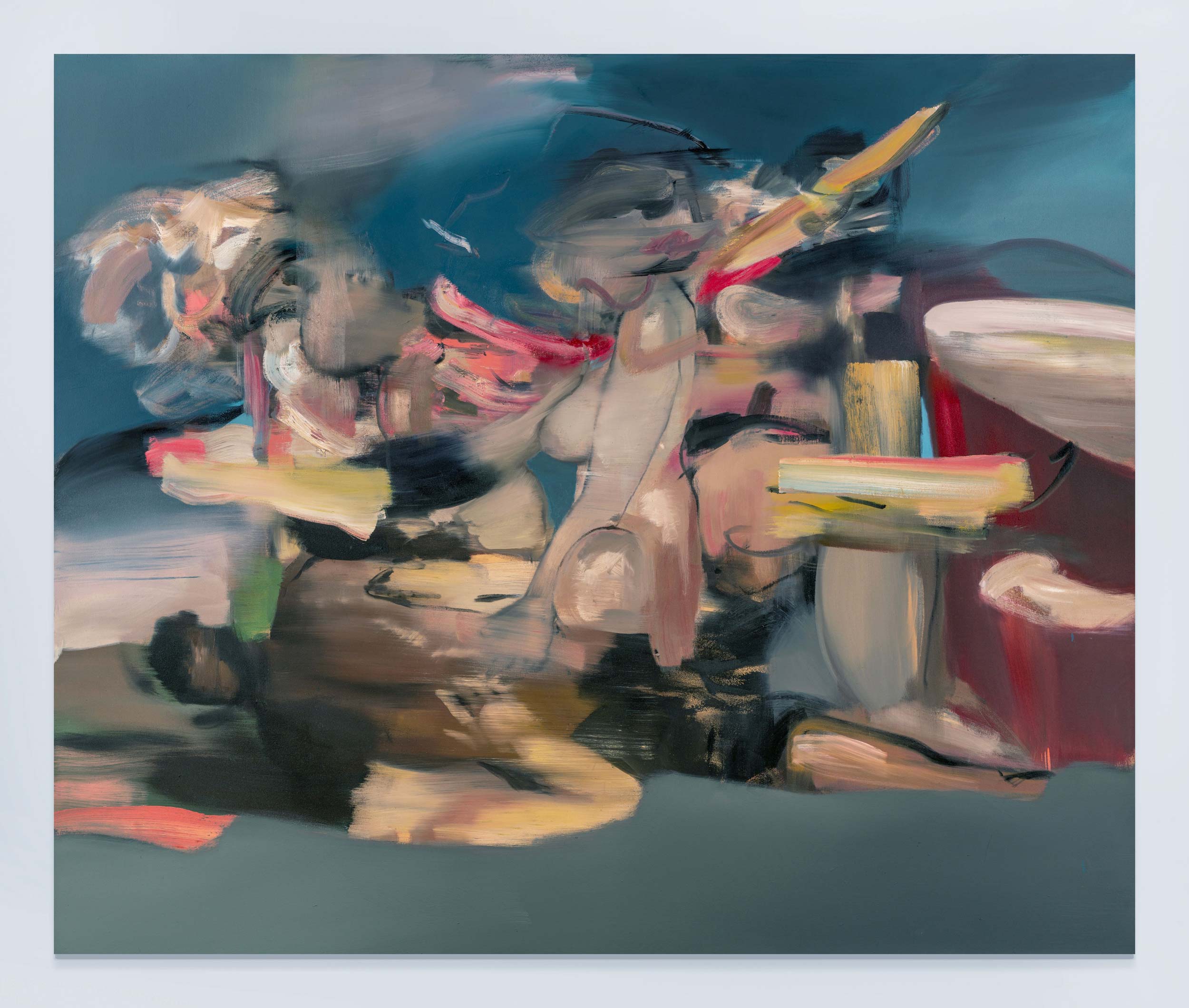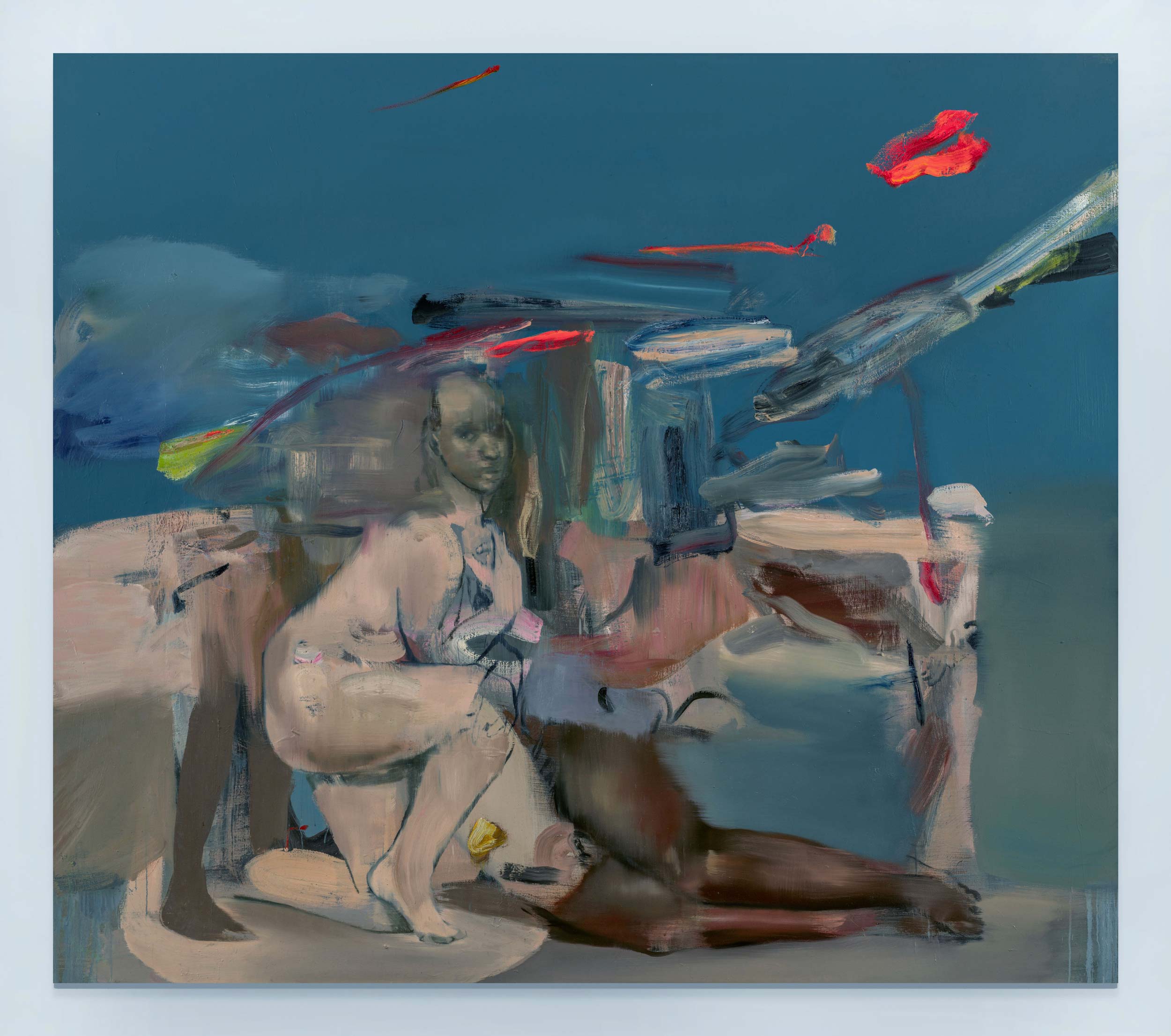‘Endless Songs,’ on view at Nicola Vassell, renders artwork imbued with life’s contradictory essence
George Rouy’s figurative practice is an exercise in introspection—an attempt at mapping the turmoil of the human experience. With densely-textured paint, dynamic abstraction, and vibrant color, his artworks bring into focus the corporeal involucrum mediating our interactions with the outer world, only to unveil what’s happening deep within us, in spaces that eyes can’t reach and hands can’t feel.
At first curvilinear, monochromatic, and soft-edged—more akin to primordial depictions of the human figure than to the shape-shifting silhouettes fronted by his contemporary inspirations—Rouy’s bodies have been progressively stripped of their voluminous, soothing features to mirror the restlessness of the human condition. Now fluid and elusive, the protagonists of his chameleonic canvases represent “the opposite tensions that orchestrate our relationship with others, ourselves, and the spaces we come to inhabit.”
From the set of a photoshoot in Paris, the London-based artist and Camberwell College of Arts graduate explains that the transition toward a more rarefied, deconstructed understanding of the human form went hand in hand with the progression of his journey into art-making. “It took me a long time to express myself without having to feed into people’s expectations about my work,” Rouy explains. “Whether emotionally or artistically, I have now gained enough experience to know what my paintings should feel like, to achieve the end result I originally wanted to obtain.” For the Sittingbourne-born painter, honing your craft means allowing yourself the time necessary to let your work brew before taking it elsewhere.
On view at New York’s Nicola Vassell Gallery between September 7 and October 21, Endless Songs, Rouy’s latest solo exhibition, feels like a testament to the evolution of his practice. In this new series of immersive paintings, the artist presents viewers with a collection of group scenes modeled off his love of the Old Masters and abstract expressionism. At once violent and ethereal, his canvases dissect the physicality of the body to expose the tangled inner workings of our time on Earth. To mark the opening of the showcase, Rouy takes stock of his artistic growth thus far, reflecting on the “universal” message subtly plastered onto his bold paintings.
Gilda Bruno: It might be a bit of a cliché question, but it always makes a good icebreaker: What does art represent for you, and how did it make its way into your life?
George Rouy: Art always felt like the best way to communicate for me. It was the only thing that allowed me to express myself while also making me feel grounded—I never particularly enjoyed sitting still in the classroom. One day, my dad took me to London’s Saatchi Gallery and Tate Britain—I must have been nine, but those early visits lit a fire in me. I remember gazing in awe at some of the paintings on display; it was a feeling I had never experienced before. In my school years, some of my teachers would let me stay in the art room past regular hours or at lunchtime. When off class, I would spend time at different art clubs. As a teenager, all I cared about was drawing and painting. It all happened very naturally, it just felt right.
Gilda: Who were the first artists to catch your attention?
George: I fell for art when the Young British Artists were taking over the creative scene. I remember seeing Chris Ofili’s paintings—which incorporate elephant dung—and thinking they were absolutely incredible. The Chapman Brothers are another one of my earliest influences; I was very drawn to sculpture at the time, including Damien Hirst’s large-scale installations. Stepping into the art world and uncovering its possibilities was such an energizing experience. From the beginning, I knew there was a lot to achieve in pursuing this path. Besides contemporary art, visiting Tate Britain and familiarizing myself with its more traditional, centuries-spanning collection really left a mark on me: I always loved classical paintings, so straddling these two extremes just filled me with so much.
Gilda: Growing up, was there ever an artist you dreamed of becoming?
George: Rather than aspiring to be like one of the artists I looked up to, I just knew that I wanted to be an artist myself. Still, it wasn’t something that you could easily tell people as it was seen as the equivalent of wanting to be a rockstar or a footballer—those kinds of pipe dreams that everyone sees as unattainable and a little naive. I did, however, dream of having the same impact that my favorite artists had managed to have [on me].
Gilda: If there is anything that makes your art stand out, it must be your ability to absorb the audience in a feeling or atmosphere. What drives your creative experimentation?
George: My work is an emotional, intuitive response to the body and the space around it. In each one of my canvases, you don’t only have subjects but also the ‘air’ wherein they move, which somehow ‘hits’—or reacts to—the physicality of the human element. Recently, the essence of oneself, the power of a precise feeling or emotion over the representation of the body itself has become more and more apparent within my craft. My focus has shifted toward portraying different states of being: We all exist on this Earth, we are all bouncing around it, experiencing things externally as much as internally. Everyone’s sensorial understanding of the world is inherently subjective; my practice strives to emphasize those subtleties.
Gilda: Ever since your earliest paintings, you’ve always paid great attention to the human form. Where does your fixation with the body stem from?
George: I have always been inspired by figurative painting. As much as I love abstraction, I find paintings are most potent when they carry the essence of the figure they aim to represent. There is something more psychological within that, and I have intentionally highlighted [that] in my newest canvases.
When I first approached the human figure, I was still searching for a stronger sense of direction in my craft. Throughout my university years, I had felt as if every stylistic choice had to be motivated by a clear reason. After graduating, I had to strip back those constraints to let myself breathe as an artist. At the time, figurative painting was so remote from what was spoken about in the art world that I began to question whether it was worth pursuing. In my mind though, I knew I had to go back to looking at art as a means of communicating my vision rather than someone else’s. It was only through spending more time at the studio that I found a way of visualizing what it means to feel something and painting it from my own perspective.
“My work is an emotional, intuitive response to the body and the space around it.”
Gilda: You have talked about how your representation of the body evolved as you gradually came into your own as an artist. But what else triggered this shift?
George: I became increasingly interested in the non-space in which my figures exist; that area plays a crucial role in shaping the composition of the work and how it is supposed to make you feel. Somewhere along the way, I decided I wanted to merge my subjects’ outer and inner worlds, allowing their viscerality to bleed into their surroundings. From there, I began to reflect more on the idea of mass—intended as both a collective of people and the elements that compose a single body—and how you can translate that, its movements and ever-shifting nature onto canvas. Théodore Géricault’s The Raft of the Medusa (1818-1819)—a large-scale painting so immersive it literally sucks you in—is the perfect example of how powerful group scenes can be. A similar intensity can be found in British painter Cecily Brown’s work, which is just as alluring and inspiring.
Gilda: Your approach to depicting the human form isn’t the only one to have changed. If your early paintings only featured a couple of shades at a time, your recent work presents viewers with a tumultuous explosion of color. Would you agree if I said that, just like the space enfolding the protagonists of your canvases represents the energy unleashed by the colliding of their physical and emotional spheres, color has acquired a more symbolic function in your work?
George: Definitely, and I feel like it happened all at once. I went from acrylic to oil paint, and began to portray figures by stretching out the limits of their physical silhouettes—taking their bodily presence ‘outside’ of their fleshy boundaries and into the atmosphere of the canvas itself. The progression toward a more varied palette was a result of that process. Color allowed me to experiment with effects that I never thought would work. Contemporary artists like Daniel Richter showed me the possibilities that lie in disrupting conventional color schemes. I was only 21 when I left university and, right after graduating, I felt the pressure to hit the art scene right away. The truth is that I wasn’t necessarily ready for that. I needed time to process my craft and understand where I wanted to take it.
Gilda: Endless Songs bears witness to the U-turns that your artistic production has undergone over the last couple of years. What does the title of this showcase stand for?
George: Sometimes things just come to you, and that’s what happened with Endless Songs. I wanted the title of this show to feel optimistic and universal. To me, the word song speaks to the continuation of time—human time in particular. A song, conceived as a narrative or a story, is something that is passed on from generation to generation. The showcase takes this symbolic concept into a wider conversation, fostering a dialogue on the human condition, history, and the experience of time. Time can be looked at from a collective or a personal perspective, at a macro or a micro level. It can refer to those pivotal events in history as well as to the tight-knit moments that make up our lives. I like my titles to have a connection to the body and the core of human nature. Endless Songs refers to both ideas in a metaphorical way: It captures ‘the poetry’ of people, for good or for worse.
Gilda: Your art has often been described as seductive or even openly sexual. To what extent do you agree with that definition?
George: It is frustrating when all viewers see in my canvases is sex. You could say my compositions are sensual—they show multiple figures crawling or clinging onto each other, if not entangled—but there are more facets to them. In one of the paintings from Endless Songs, two people get crushed under a bundle of bodies; rather than just mimicking a sex scene, the work conveys the idea of dominance, or suffocation almost, in the wider sense. Elsewhere in the show, multiple subjects hold up another figure, who serves as the central focus point of that canvas, quite literally ‘uplifting’ them. My interest lies in the conflicts and contrasts setting the pace for the human experience. Pain, grief, anxiety, ease, joy, and hope are all key components of my work. Despite being nudes, I wouldn’t say that my paintings are inherently sexual. Of course, they touch upon sex, but only as a metaphor for the carnal, emotional, and psychological frictions that characterize our existence.
Gilda: Your artworks seem to draw on and embody the disorienting energy of chaos. Do you thrive in disorder or strive for stability?
George: Nothing is ever set in stone, and that is something I had to come to terms with through the years. In the past, my OCD led me to constantly look for certainty and reassurance, but that came with a certain rigidness, which created more problems than it solved. The chaotic essence of my paintings is possibly one of the most personal traits in my craft. The more I dug into things I was going through, the more I realized that everything—emotions, feelings, relationships, everyday situations—is in constant flux, and that the only way to live a decent life is to embrace that precariousness. This narrative shift granted me a new perspective on things; it didn’t only change my work, which is now much more evocative of the person and artist I am, but it also revolutionized my understanding of society, of everything that happens within or outside of myself.
Gilda: You are one of the most exciting figurative painters on the contemporary art scene. How do you cope with the pressure that comes from such a reputation?
George: When I first came onto the scene, I had an existential moment where I thought, If I continue going down this route artistically, nothing good is ever going to come out of it. I felt as if I couldn’t keep up with the expectations I had about my creative journey. That is when my own strength, dedication and foresight really made the difference. As an artist, you are on your own jet. Regardless of how anyone else is receiving your work, you need to be able to stick to the original plan you had for it. A great chunk of my audience consumes my work at face value, whereas I always try to think about it from a long-term perspective: How is each of my canvases laying the foundation for what’s yet to come? What does my trajectory look like moving forward? And what does that mean for my personal and professional evolution?
Gilda: What would you like art to grant you in the future? What are you hoping other people will make of your work?
George: As a child, I dreamed of having my paintings in the collection of a museum so that anyone could be inspired by them. Deep down, I am still hoping that that dream will come true one day. My goal is to allow viewers to enter my canvases, and by entering, I mean being able to digest them thoroughly. I want my audience to feel something in their stomach when they glance at my work, something they can’t quite understand and yet, brings them closer together. All I can do is hone in on my experiences and hope that others will see themselves in them. My craft sits the best within the intangible, fleeting nature of feelings—the stuff that can’t be put into an essay. That is what will continue to show me new ways of taking my brush into unexpected directions in the future.













